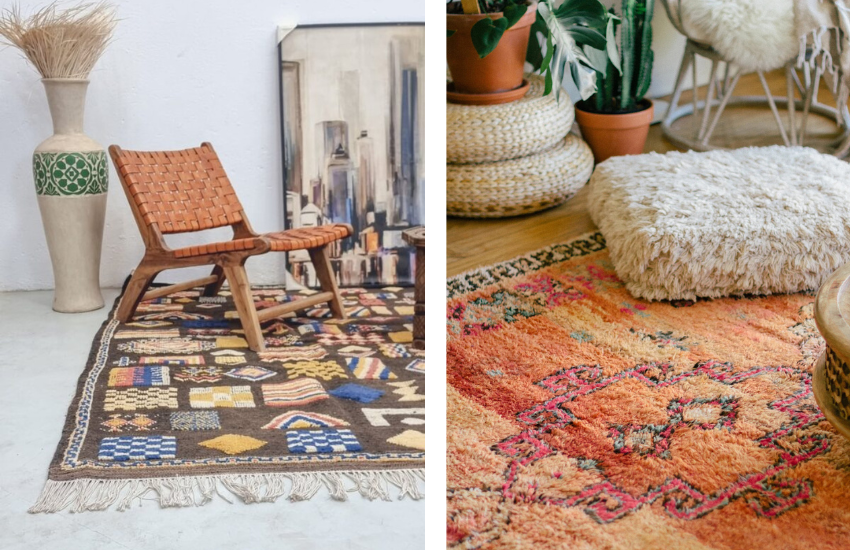Business
Berber Rug: A Blend of Timeless Style and Cozy Comfort
Published
7 months agoon
By
Bilal
A Berber rug is more than just a decorative piece for your home—it’s a functional art form that blends timeless style with cozy comfort. Its rich history, craftsmanship, and versatility have made it a favorite choice for interiors around the world. Whether you’re looking for a Moroccan Berber rug to add texture and warmth to your living room or a wool Berber rug to complement a modern minimalist setting, there is no denying the unique charm of these rugs. In this article, we will explore the different types of Berber rugs, their origins, materials, and how they continue to enhance both traditional and contemporary interiors.
Berber Rug Bio Profile
| Attribute | Details |
|---|---|
| Origin | Morocco, North Africa |
| Materials | Wool, cotton, jute, sometimes silk |
| Traditional Use | Used by Berber tribes for warmth and protection |
| Key Features | Thick, plush, and textured weaving |
| Dimensions | Common sizes: 8×10, 5×8, custom sizes |
| Popular Styles | Geometric patterns, tribal motifs, neutral tones |
| Maintenance | Regular vacuuming, occasional professional cleaning |
What is a Berber Rug?

A Berber rug is a handcrafted textile traditionally made by the Berber people of North Africa. Known for their distinctive, textured weaves, these rugs are primarily made from natural fibers like wool, though variations can include cotton or jute. The wool Berber rug is particularly prized for its softness, durability, and insulating properties. Berber rugs are often characterized by their bold geometric patterns, neutral colors, and minimalist designs, which reflect the nomadic lifestyle of the Berber tribes. Their weaving techniques have been passed down through generations, creating a piece of functional art that stands the test of time.
The History and Origins of Berber Rugs
The origins of Berber rugs date back thousands of years to the Berber tribes of Morocco, Algeria, Tunisia, and other regions in North Africa. These rugs were originally crafted for practical purposes, such as insulating the floors of tents or adding warmth to homes during the colder months. Over time, they evolved into highly regarded artisanal pieces, often woven by hand using natural dyes and techniques that were locally sourced. The intricate geometric patterns often found on these rugs have symbolic meanings, representing various aspects of the Berber tribes’ culture and beliefs.
Why Choose a Moroccan Berber Rug?
One of the most popular and sought-after varieties of Berber rugs is the Moroccan Berber rug. These rugs are often crafted by artisans from the Atlas Mountains or other regions in Morocco, where the Berber people have a long history of rug-making. The unique blend of culture, tradition, and craftsmanship makes the Moroccan Berber rug a versatile piece that complements both traditional and modern interiors. Whether you’re looking for a bold, statement-making rug or a more subtle, neutral-toned piece, these rugs are known for their quality and timeless beauty. Moroccan Berber rugs are often distinguished by their plush pile, vibrant colors, and abstract designs, which have become synonymous with bohemian and contemporary interior styles test.
The Popularity of the 8×10 Berber Rug
When it comes to selecting the right Berber rug for your space, size plays a critical role. One of the most common dimensions for these rugs is 8×10 feet, making it an ideal size for living rooms, dining areas, or larger bedrooms. The Berber rug 8×10 strikes the perfect balance between functionality and aesthetic appeal. Its larger size ensures that the rug becomes a focal point in the room while offering ample coverage for comfort and warmth. Whether you’re placing it under a coffee table, in a seating area, or as a statement piece in a hallway, the 8×10 Berber rug provides both style and comfort.
Material Choices: Wool vs. Other Fabrics

One of the key elements that sets Berber rugs apart from other types of rugs is the material used in their creation. Wool Berber rugs, in particular, are highly coveted for their softness, durability, and natural insulating properties. Wool is an ideal fiber for rug making due to its ability to retain warmth, resist dirt, and stand up to heavy foot traffic. The natural texture of wool also gives the Berber rug its distinctive, plush feel, making it a perfect addition to living rooms, bedrooms, or even high-traffic areas like hallways.
Though wool is the most common material, Berber rugs can also be made from other natural fibers such as cotton or jute, offering different textures and finishes. Cotton Berber rugs tend to be lighter and more affordable, while jute offers a rustic, eco-friendly option. However, for those looking for ultimate luxury and warmth, wool Berber rugs remain the top choice.
Key Features of Berber Rugs: Geometric Patterns and Neutral Tones
One of the most recognizable characteristics of a Berber rug is its distinctive geometric patterns. Whether it’s bold diamonds, zigzags, or minimalist lines, these patterns are not only visually striking but also hold cultural significance. The geometric motifs on Berber rugs often reflect the natural world, tribal traditions, or spiritual beliefs, making them more than just aesthetic pieces. Many of the Moroccan Berber rugs, in particular, use white or neutral tones such as ivory, beige, and gray, allowing them to seamlessly blend into a variety of interior design styles, from traditional to contemporary.
These rugs often feature a thick, knotted pile that gives them a luxurious, textured feel. Whether the pattern is bold or subtle, the quality of craftsmanship and design makes Berber rugs an enduring favorite.
How to Care for Your Berber Rug
To ensure that your Berber rug lasts for years and retains its beauty, proper maintenance is essential. Regular vacuuming will help prevent dirt and dust buildup, particularly in the dense fibers. It’s best to use a vacuum with adjustable suction to avoid damaging the pile. When spills or stains occur, blot the area gently with a clean cloth, and avoid using harsh chemicals that could damage the wool. For deep cleaning, it is advisable to have your Berber rug professionally cleaned, as improper cleaning methods can lead to fiber damage.
Where to Use Berber Rugs in Your Home
Berber rugs are incredibly versatile and can be used in almost any room of the home. The thick, plush texture makes them a great choice for areas where you want added comfort, such as living rooms, bedrooms, or reading nooks. The larger Berber rug 8×10 is particularly well-suited for dining rooms or spacious living areas where it can anchor the furniture and create a cohesive design. The neutral tones of Moroccan Berber rugs make them a natural fit for minimalist interiors, while their intricate patterns can complement bohemian or eclectic spaces.
The Timeless Appeal of Berber Rugs
The enduring appeal of Berber rugs lies in their ability to combine style, comfort, and durability. These rugs have been treasured for centuries and remain a symbol of craftsmanship and cultural pride. Whether you’re drawn to the bold geometric patterns of a Moroccan Berber rug or the plush texture of a wool Berber rug, these pieces offer more than just aesthetic value—they bring warmth, history, and a sense of authenticity to any space. With proper care, a Berber rug can last for generations, making it a worthy investment for your home.
Conclusion
Incorporating a Berber rug into your home not only adds warmth and style but also connects you with a rich cultural tradition. From the intricate geometric designs of Moroccan Berber rugs to the luxurious feel of wool Berber rugs, these pieces are versatile, timeless, and full of character. Whether you opt for a smaller accent piece or a larger 8×10 Berber rug to make a statement, you’re sure to enjoy the comfort, beauty, and craftsmanship that these rugs offer.
For More Latest Update Las Vegas Times

Who Is Cruz Beckham? The Singer and Style Icon Emerging from David Beckham’s Famous Family

Who Is Kendall Schmidt? Inside the Life of the American Singer-Songwriter and Music Producer

Who Is Wendell James? Spotlight on the Actor’s

Who Is Elizabeth Rizzini? Inside the BBC Weather Presenter’s Life, Career, and Personal Journey

Who Is Mason Reese? All About the American Former Child Actor’s

Who Is Lynn Hamilton? Celebrating the Life and Legacy of the American Actress

Who is Mickey Gooch Jr? The Dynamic Journey of a Film Producer and Actor

Who Is Pierre Bouvier? All About the Canadian Singer and Musician Behind Simple Plan

Who Is Pearl Minnie Anderson? Rising Star in Maya Rudolph’s Legacy

Who is Minnie Pearl? The American Comedian Who Brought Country Humor to the Spotlight

Who Is James Lesure? All About the American Film and Television Actor

Who is Eric Weinberger? A Visionary Television Producer Shaping Sports Media

Who is Charlee Fraser? The Rise of the Australian Model and Actress Making Global Waves

Who Is Avantika Vandanapu? Rising American Actress & Singer

Who is Tracey Hinds? Exploring the Life of Macy Gray’s Ex-Husband and Mortgage Broker

Who Is Kavan Smith? The Canadian Actor Known for His Versatile Roles

Who Is Markella Kavenagh? All About the Australian Actress and Rising Star

Who is Olivia Rose Cameron: The Creative Artist & Daughter of Kirk Cameron

Who Is Pearl Minnie Anderson? Rising Star in Maya Rudolph’s Legacy

Who Is Pierre Bouvier? All About the Canadian Singer and Musician Behind Simple Plan

Who Is Cruz Beckham? The Singer and Style Icon Emerging from David Beckham’s Famous Family

Who Is Kendall Schmidt? Inside the Life of the American Singer-Songwriter and Music Producer

Who Is Wendell James? Spotlight on the Actor’s

Who Is Elizabeth Rizzini? Inside the BBC Weather Presenter’s Life, Career, and Personal Journey

Who Is Mason Reese? All About the American Former Child Actor’s

Who Is Lynn Hamilton? Celebrating the Life and Legacy of the American Actress

Who is Mickey Gooch Jr? The Dynamic Journey of a Film Producer and Actor

Who Is Pierre Bouvier? All About the Canadian Singer and Musician Behind Simple Plan

Who Is Pearl Minnie Anderson? Rising Star in Maya Rudolph’s Legacy

Who is Minnie Pearl? The American Comedian Who Brought Country Humor to the Spotlight
Trending
-

 Celebrity12 months ago
Celebrity12 months agoNecati Arabacı: Net Worth, Biography, and More
-

 Celebrity1 year ago
Celebrity1 year agoDiscovering Lily Phillips: An Insight into Her Life and Career
-

 Celebrity12 months ago
Celebrity12 months agoEnrica Cenzatti: Life of Andrea Bocelli’s Ex-Wife
-

 Celebrity1 year ago
Celebrity1 year agoParker Schnabel’s Girlfriend: A Comprehensive Look at His Relationships Over the Years
